La Celestina Characters: Characteristics
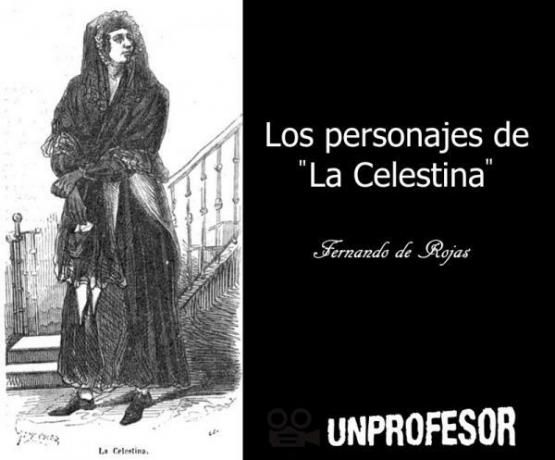
The literary work La Celestina It was written by Fernando de Rojas between 1496 and 1499 and published in that same year. Is tragicomedy, which was originally called Tragicomedia de Calisto y Melibea, is one of the classics of Spanish literature that reflects the change of mentality that occurred towards the end of the fifteenth century, since in Renaissance humanism more importance began to be given to the love. This work is considered a faithful reflection of the behavior of people at that time, since its main and secondary characters are very natural, being interested above all in things earthly.
In addition, in order to fully understand how the events unfold in this story, it is very important to have present the physical and psychological characteristics of their characters, in this lesson of a PROFESSOR we offer you all about the Characteristics of the La Celestina characters in a short summary to make it easier for you to study. So, if you need to know in detail those who star in this literary work and their companions, do not miss any details.
Index
- La Celestina: main and secondary characters
- Main characters of the Celestina: Calisto
- Main characters of La Celestina: Melibea
- Main characters of La Celestina: Celestina
- Characteristics of the secondary characters of La Celestina
- The language of La Celestina
La Celestina: main and secondary characters.
On La Celestina are reflected the different changes that society underwent when moving from a medieval mentality to a Renaissance, gaining weight ideas and concepts such as love, pleasure and sensuality, among other aspects more earthly. All this can be discerned in this story thanks to what happens between a young noble named Callisto, a young woman of high birth. called Melibea and the goings-on carried out by the sorceress and pimp known as Celestina to unite these two youths.
To begin with this brief summary of the Characteristics of the La Celestina characters, we will talk about the fact that in this work two types of characters are very well differentiated, those that have more weight in the main plots and those that are observed in the secondary plots.
Thus, the characters in La Celestina are divided into main and secondary characters and, as is usual in all stories, although the weight of the work falls on the former, without the appearance of the secondary ones, the main plots would lose details and even some sense. Thus, in this story we find the following characters:
Main characters of La Celestina
- Callisto
- Melibea
- Celestina
Secondary characters in La Celestina
- Sempronio
- Parmeno
- Areúsa and Elicia
- Alisa and Pleberio
- Sosia and Tristan
- Lucrecia
If you need to know better the complete argument of this work by Fernando de Rojas, discover in this other lesson from a Professor ashort summary of La Celestina so you can easily delve into this story considered a classic of Spanish literature.
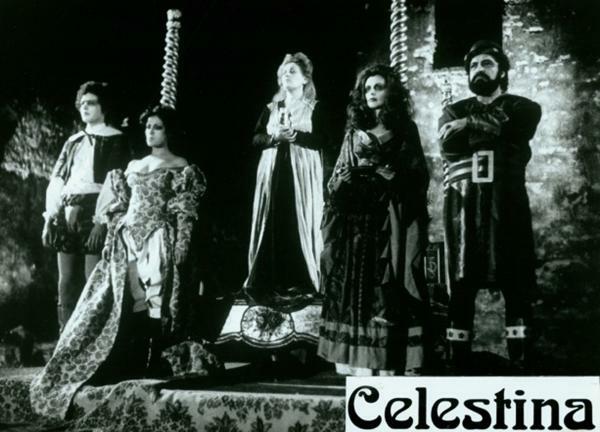
Main characters of the Celestina: Calisto.
In this story in which Fernando de Rojas managed to create deep characters and well defined that very well represented various aspects of the time, thanks to this, we can see that in it two social classes are very well differentiated: the nobility and the poor. Within the nobility are the families of high birth that and in poverty we see all the others, whether they are the sorceress, the prostitutes or the servants.
To comment carefully on the details about each of the members of this story, we will first focus on talking about the characteristics of the main characters of La Celestina.
Thus, we will start by talking about the first member who appears on the scene, Callisto. He is one of the protagonists, the only male main character, who represents a young nobleman who falls in love at first sight of a young woman of high birth. This happens when, at the beginning of everything, Callisto goes out in search of her hunting hawk and ends up in the young nobleman's garden and sees her. At that precise moment he falls madly in love with her beauty and begins to talk to her, letting her know her feelings about her, but she rejects him.
Here the story begins, when this nobleman becomes a madman in love who becomes selfish and puts aside all reason to make Melibea, the young woman, fall at her feet. But, after getting what he wants, Calisto suffers an accident when he fled so as not to be discovered by Melibea's parents in the girl's bedroom and dies.
This is a member of this work who, due to being lovesick, is very easy to manipulate and, therefore, some characters take advantage of him to get money and other benefits. Thus, Callisto represents the ridiculous lover figure or comic, since then it was considered that love was a form of madness or, even, a disease that led you to stop being yourself to become someone pathetic. In addition, the way this character develops and speaks is considered very literary and somewhat artificial.
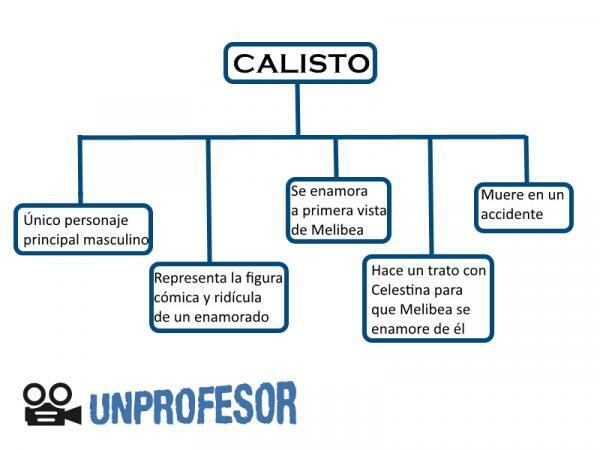
Main characters of La Celestina: Melibea.
To continue talking about the characteristics of the characters in La Celestina, we will focus on one of the female co-stars, Melibea. She is about a young woman of high birth who represents the ideal woman she of the time, since she is very good and innocent as well as beautiful and noble. In addition, she has sufficient criteria and she is considered a mature character because, among other aspects, she does not fall for the praise of the young nobleman the first time they meet.
After Callisto hires Celestina to bewitch the young noblewoman and she falls in love with him, Melibea stops being herself and becomes madly in love with her to the point of give her soul and her virginity to the young man. One of the times they are in his bedroom, the lovers fall asleep and the next morning, so that Melibea's parents do not find them, Calisto flees by jumping the garden gate. In doing so, she stumbles and falls, dying on the spot and, when the young woman sees him, she decides to tell her parents everything and jump from a window, killing her.
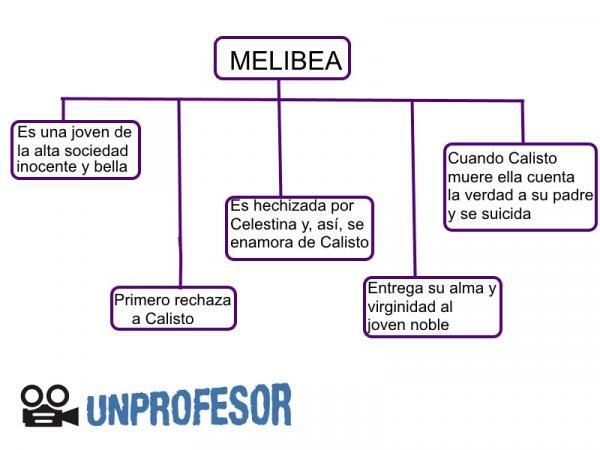
Main characters of La Celestina: Celestina.
Ending with the main characters of La Celestina, we talk about the member who gives this story its name, the sorceress Celestina. She is a woman who has always been poor and, in order to survive, she has become a person interested, who always seeks economic benefit, calculates all her movements and leaves aside the moral.
She is known for being a procurer and getting with sorcery what people need, for this reason, Sempronio who knows her for being In love with one of the prostitutes that Celestina cares for, he recommends her lord Calisto of her to go to her to get Melibea to she fell in love with him. Celestina, who needs the money and doesn't mind manipulating others, negotiates a price with the young nobleman and she bewitches Melibea through a few skeins of yarn.
Celestina had agreed with Callisto's servants to share the profits, since her dealings with Callisto get it together, but when the pimp collects the money she decides not to distribute it with they. This causes that Sempronio and Pármeno get angry in an exaggerated way and, in the end, they kill Celestina, but for this they are judged and beheaded.
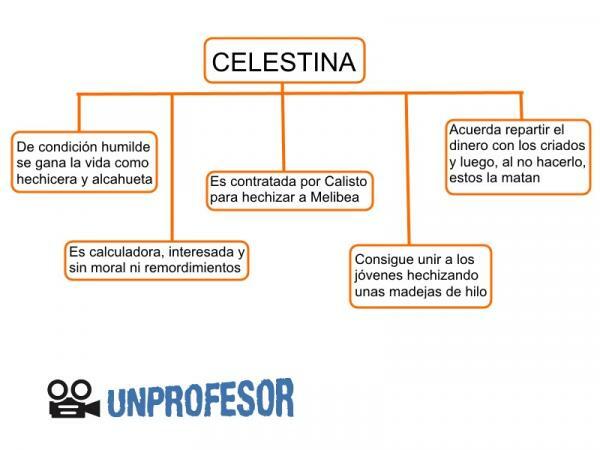
Characteristics of the secondary characters of La Celestina.
To end this summary on the Characteristics of the La Celestina characters, We still have to comment on the different secondary characters in this story. As we have already pointed out before, although these are not the main protagonists, without them, part of the work would lack meaning, since some of them are in charge of weaving plots that lead the protagonists to take their decisions.
Below you will find all the details about the characteristics of the secondary characters of La Celestina:
Sempronio
He is Callisto's personal servant, so he accompanies him everywhere and advises him on various matters. Sempronio, upon discovering that the young nobel has fallen in love with a young woman of high birth who has rejected him and that this he is heartbroken and just looking for a solution, he thinks about helping his love but, at the same time, taking advantage of the situation.
Thus, the servant recommends that Callisto visit the sorceress and pimp known as Celestina. But, at the same time, he makes a deal with her to take a part of her benefits and, in addition, to be able to be with Elicia, her lover with whom he has a very passionate relationship. Represents a selfish character and interested in achieving his goals in any way necessary.
Parmeno
This secondary character is another servant of the young nobleman but, contrary to his companion, his Sempronio, he has strong morals and well-defined values. For this reason, it does not seem correct for Sempronio to take advantage of his lord and warn him not to go to Celestina, since she is a sorceress and many unexpected things can happen. But, Celestina, realizing this, manages to dissuade the servant by offering him power to stay with Areúsa, Elicia's companion, for whom Pármeno feels a great attraction.
He represents the fact that even a man with good intentions can be manipulated as long as he is offered what he wants, therefore he reflects humanity's weakness in the face of desires.
Areúsa and Elicia
These two young women are prostitutes who are in charge of the procurer Celestina and in this story with a mentality from the beginning rebirth represent sensuality, lust, and even the low morale of those who need to do what is necessary to survive. Thus, Celestina uses them to successfully convince Callisto's servants.
Alisa and Pleberio
Alisa and Pleberio are bourgeois and are Melibea's parents. They appear very little on the scene, in fact, only at the beginning and at the end when they discover that their daughter has committed suicide by losing his beloved, whom in reality he had only come to love due to the spell of Celestina.
Sosia and Tristan
They are two of Callisto's servants who replace Pármeno and Sempronio when they die. They are considered faithful, confident and good advisers, but at the same time they are very curious and are aware of everything that happens.
Lucrecia
She is one of Melibea's main maids and she listens to everything that her wife tells her and advises her on what she asks of him. At times it can be seen that Lucrecia is jealous of her noble lovers.
The language of La Celestina.
A very striking element of this literary classic is the language it uses. And it is that this work appeared at a time when two very different literary movements were coexisting: the medieval and renaissance world. Therefore, the cultured and the popular footprint converge in this work and will determine both its language and its style.
Usually in Celestina we find a llanguage that moves between the cultured and the popular. Latinizing elements abound but, also, the speech of some characters is full of popular elements such as worldly expressions or sayings. However, cultured and Latin expressions are usually put in the mouths of the richest characters to give them an air of greater rank.
Here we discover some outstanding elements of the language of La Celestina so that you can better analyze the linguistic part of the work:
- Verb at the end of the sentence: This is an influence of Latin since in this language it is always customary to organize sentences with the verb in the final position
- Latin lexicon: There is also a strong presence of the Latin lexicon in the speech of the characters, especially in those who are richer or have a better social position
- Use of the infinitive and participle present
- Popular language: As we have already said, there is also a strong trace of the most popular language with dialectisms, popular expressions and sayings
We must make it clear that the use of one type of language or another is determined by the social stratum of the character. That is to say, the most cultured and Latinizing language is used by lords or aristocrats, on the other hand, the colloquial lexicon usually belongs to figures such as servants who present a large number of elements such as vulgarisms, sayings, etc.
In general, La Celestina abounds with dialogue that introduces the characters and defends their positions in different situations. However, there is also room for monologues that are used so that the characters can penetrate more into their souls and that the viewers know their true nature.

Image: Slideshare
If you want to read more articles similar to La Celestina Characters: Characteristics, we recommend that you enter our category of History of Literature.



